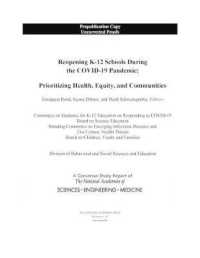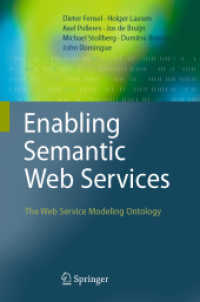- ホーム
- > 洋書
- > 英文書
- > Computer / General
Full Description
"This book will become a mainstay in your SharePoint library. You will find yourself reaching for it whenever you run into a difficult situation or need extra guidance on how to use the new SharePoint product set."- From the Foreword by Thomas Rizzo, Senior Director, SharePoint Product Management, MicrosoftThe Only Book That's Completely Focused on Maximizing the Business Value of SharePoint 2010 Solutions Essential SharePoint (R) 2010 approaches Microsoft SharePoint Server 2010 from a strict business value perspective, explaining exactly how to plan and implement SharePoint solutions to achieve superior business results. The authors are leading enterprise SharePoint consultants and draw on their unsurpassed experience to focus on the SharePoint features that offer the most real-world value. You'll find practical advice about how to succeed with knowledge management, business intelligence, and process improvement, and how to derive value from new innovations such as social tagging and mashups. The book includes comprehensive, "in the trenches" guidance on planning, architecture, governance, training, and other key issues most SharePoint books ignore. The authors identify success factors, intangibles, and "gotchas," helping you systematically reduce project risk and time-to-value ratio. Learn how to Customize your best portal or collaboration strategy Sustain a portal for continual, measurable value Leverage the new community and social features in SharePoint 2010Succeed with enterprise content management Streamline business processes with Workflow and Forms Choose the right roles for Web collaboration, search, and Microsoft Office Plan for secure external collaboration Migrate smoothly from SharePoint 2007Train and communicate for a successful launchWhether you're a business leader, IT manager, architect, analyst, developer, or consultant, this book will help you tightly align SharePoint projects with business strategy to deliver outstanding results.
Contents
Foreword xixPreface xxiAcknowledgments xxvAbout the Authors xxviiAbout the Contributors xxix Part I: Planning 1 Chapter 1: Getting Started 3Reader's Guide 4Planning a Successful SharePoint Solution Strategy 5Key Points 19 Chapter 2: Introduction to the SharePoint 2010 Platform 21Microsoft's Collaboration Evolution 23Current Versions of SharePoint Products and Technologies 26Microsoft SharePoint Server 2010 and Office 2010 27SharePoint 2010: What's New? 32Comparing SharePoint Foundation to Microsoft SharePoint Server 2010 34SharePoint: The File Share Killer 35SharePoint: The Access and Excel Killer 45Key Points 57 Chapter 3: SharePoint 2010: Architecture Fundamentals 61Functional Overview 61SharePoint Fundamentals 65SharePoint Lists, Libraries, and Items 78Pages 80Navigation 81Understanding SharePoint Administration 84Physical Deployment Options 89Key Points 94 Chapter 4: Planning for Governance 97Why Is Governance Planning So Important? 97How Do I Create a Governance Plan? 100What Is in the Governance Plan? 100Key Points 121 Chapter 5: Planning Your Information Architecture 123Getting Started 125Site Architecture 129Page Architecture 135Metadata Architecture 138Maintaining Your Information Architecture 161Key Points 161 Chapter 6: Making Enterprise Content Management Work: Documents and Records 163Getting Started with ECM 164What's New for ECM in SharePoint 2010? 165Document Management 167Records Management 186Key Points 199 Chapter 7: Getting Social: Leveraging Community Features 201Getting Started: Developing a Strategy for SharePoint Community Features 202Social Networking: Engaging People 217Social Data: Enhancing Value with User Contributed Content 223Social Sites: Providing a Structure for Collaborative Conversations 230Key Points 237 Chapter 8: Planning Your Security Model 239Overview of SharePoint Security Elements 240Defining and Documenting SharePoint Security 252Maintaining Your Security Model 263Key Points 268 Chapter 9: Getting Ready to Launch: Planning for Training and Communications 271Training 272Communications 282Key Points 289 Part II: Optimizing 291 Chapter 10: Making Search Work: Content, People, Data 293Search as a Business Capability 293Using Search 294How SharePoint Search Works 300Analyzing and Designing Search 303Configuring Search 312Monitoring and Enhancing Search 319SharePoint 2010 Search: What's New? Limitations? Flavors? 319Key Points 322 Chapter 11: Making Business Processes Work: Workflow and Forms 325Getting Started with Workflow 325Workflow Terminology 327Using the Provided Workflows 328Creating Custom Workflows with SharePoint Designer 2010 338Designing Workflows with Visio 2010 354Using InfoPath 2010 to Create Electronic Forms 360Key Points 371 Chapter 12: Putting Your Site on the Web 373Why SharePoint for Internet-facing Web Sites? 374Web Content Management: The Basics 375Content Deployment: Key Terms and Architecture 380What Has Improved in SharePoint 2010 Web Content Management? 382Richer User Experience 383Additional Features 385Customizing the User Experience (UX) 389Putting It All Together: A WCM Strategy 395Key Points 397 Chapter 13: Making Business Intelligence Work 399Getting Started with Business Intelligence 400Which Presentation Tool Is Right for You? 405Excel Services 406PerformancePoint Services 411Visio Services 414Putting It All Together 415Key Points 417 Chapter 14: Composite Applications with Business Connectivity Services 419What Is a Composite Application? 420Introducing Business Connectivity Services 420BCS Components 421Types of BCS Solutions 422Getting Started with BCS 423Using an External Data column 432Building a Composite Application 432Key Points 436 Chapter 15: Office 2010 Client Applications 439What's New in Office 2010? 440Office Client Applications That Connect with SharePoint 2010 441SharePoint Workspace: Taking a SharePoint Site Offline 444Documents and Data Caching 450Backstage 457Other Clients: Office Web Applications and Office Mobile Applications 459Key Points 462 Chapter 16: Planning for Disaster Recovery: Backing Up and Restoring 465Disaster Recovery Planning 466Backup and Restore Options 467What's Not Covered in a SharePoint Backup 484Key Points 486 Part III: Migrating 487 Chapter 17: Planning Your Move from SharePoint 2007 to 2010 489You're Ready to Deploy SharePoint 2010: Now What? 489Planning Your Upgrade 490Upgrade and Migration Options 502What Plan Is Best for You? 505Upgrade Considerations 507Key Points 511 Appendix A: SharePoint User Tasks 5131. Create a New Team Site or Workspace 5142. Create a List or Document Library 5163. Apply Security to a Site or Workspace 5184. Apply Security to Lists or Document Libraries 5195. Create a View 5216. Add Web Parts to a Page 5237. Add Files to a Document Library 5258. Save a File from Office to SharePoint 5279. Add Metadata and Standardized Document Templates to a Document Library for Better Content Tagging 52910. Recover a Document from the Recycle Bin 53111. Building and Contributing to a Blog 53212. Build a Wiki 53413. Expose List Data as an RSS Feed 53514. Sign In as a Different User 53615. Enhance a Site's Navigation 53716. Work with a Document Offline 53917. Document Routing 54018. Filter and Target List Content Using an Audience 54319. Find Content by Using Search 54420. Manage "My" Information 54421. Create a List of Key Performance Indicators 54622. Make Use of Business Data 54723. Publish an Excel Workbook for Web Rendering 55024. Publish an InfoPath Form for Web Rendering 552Key Points 552 Index 555








